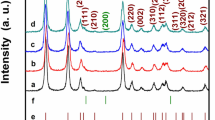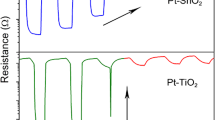Abstract
Room temperature gas-sensitive metal oxides have received growing concern over their long-term stability in recent years. Presently, Pt-SnO2 composite nanoceramics of 1 wt% Pt have been prepared, and the time dependence of their room temperature hydrogen sensing capability has been carefully studied. A strong variation with time was observed, with the room temperature response to 1% H2− 20% O2–N2 decreased by a factor of several dozen after only one week. Heat treatments were found highly effective to activate those aged samples. Their room temperature hydrogen sensing capability was almost completely restored through 10 min heat treatments at temperatures as low as 130 °C. It is proposed that impurity gases in air slowly deposit on Pt in Pt–SnO2 composite nanoceramics, and the catalytic role of Pt is deactivated by the deposition and then activated after their desorption through heat treatments. These results suggest that periodic mild heat treatments can be a simple and feasible way for some room temperature gas-sensitive metal oxides to maintain a high long-term stability.








Similar content being viewed by others
References
Park CO, Akbar SA (2003) Ceramics for chemical sensing. J Mater Sci 38:4611–4637. https://doi.org/10.1023/A:1027402430153
Arya SK, Krishnan S, Silva H, Jean S, Bhansali S (2012) Advances in materials for room temperature hydrogen sensors. Analyst 137:2743–2756
Korotcenkov G (2013), Handbook of gas sensor materials, Properties, advantages and shortcomings for applications 2
Urasinska-Wojcik B, Vincent TA, Chowdhury MF, Gardner JW (2017) Ultrasensitive WO3 gas sensors for NO2 detection in air and low oxygen environment. Sens Actuators B 239:1051–1059
Bicelli S, Depari A, Faglia G, Flammini A, Fort A, Mugnaini M et al (2009) Model and experimental characterization of the dynamic behavior of low-power carbon monoxide MOX sensors operated with pulsed temperature profiles. IEEE Trans Instrum Meas 58:1324–1332
Bhati VS, Hojamberdiev M, Kumar M (2020) Enhanced sensing performance of ZnO nanostructures-based gas sensors: a review. Energy Rep 6:46–62
Alenezy EK, Sabri YM, Kandjani AE, Korcoban D, Rashid S, Ippolito SJ et al (2020) Low-temperature hydrogen sensor: enhanced performance enabled through photoactive Pd-decorated TiO2 colloidal crystals. Acs Sens 5:3902–3914
Zhang DZ, Liu JJ, Jiang CX, Liu AM, Xia BK (2017) Quantitative detection of formaldehyde and ammonia gas via metal oxide-modified graphene-based sensor array combining with neural network model. Sens Actuators B 240:55–65
Tan JF, Dun MH, Li L, Zhao JY, Tan WH, Lin ZD et al (2017) Synthesis of hollow and hollowed-out Co3O4 microspheres assembled by porous ultrathin nanosheets for ethanol gas sensors: responding and recovering in one second. Sens Actuators B 249:44–52
Zhu S, Liu Y, Wu GT, Fei LF, Zhang SH, Hu YM et al (2019) Mechanism study on extraordinary room-temperature CO sensing capabilities of Pd-SnO2 composite nanoceramics. Sens Actuators B 285:49–55
Song CB, Wu GT, Sun BL, Xiong Y, Zhu S, Hu YM et al (2017) Pt-WO3 porous composite ceramics outstanding for sensing low concentrations of hydrogen in air at room temperature. Int J Hydrog Energy 42:6420–6424
Liu M, Li PC, Huang Y, Cheng L, Hu YM, Tang ZL et al (2021) Room-temperature hydrogen-sensing capabilities of Pt-SnO2 and Pt-ZnO composite nanoceramics occur via two different mechanisms. Nanomaterials 11:9
Du Y, Gao S, Mao ZH, Zhang CL, Zhao QF, Zhang SP (2017) Aerobic and anaerobic H2 sensing sensors fabricated by diffusion membranes depositing on Pt-ZnO film. Sens Actuators B 252:239–250
Chen H, Liu ZY, Fu G (2011) Analysis of the aging characteristics of SnO2 gas sensors. Sens Actuators B 156:912–917
Nelli P, Faglia G, Sberveglieri G, Cereda E, Gabetta G, Dieguez A et al (2000) The aging effect on SnO2-Au thin film sensors: electrical and structural characterization. Thin Solid Films 371:249–253
Itoh T, Matsubara I, Kadosaki M, Sakai Y, Shin W, Izu N et al (2010) Effects of high-humidity aging on platinum palladium, and gold loaded tin oxide-volatile organic compound sensors. Sensors 10:6513–6521
Zhu S, Li PC, Wu GT, Li ZY, Wu P, Hu YM et al (2018) Extraordinary room-temperature hydrogen sensing capabilities with high humidity tolerance of Pt-SnO2 composite nanoceramics prepared using SnO2 agglomerate powder. Int J Hydrogen Energy 43:21177–21185
Okazaki S, Johjima S (2014) Temperature dependence and degradation of gasochromic response behavior in hydrogen sensing with Pt/WO3 thin film. Thin Solid Films 558:411–415
Chen WP, Xiong Y, Li YS, Cui P, Guo SS, Chen W et al (2016) Extraordinary room-temperature hydrogen sensing capabilities of porous bulk Pt–TiO2 nanocomposite ceramics. Int J Hydrog Energy 41:3307–3312
Xiong Y, Chen W, Li Y, Cui P, Guo S, Chen W et al (2016) Contrasting room-temperature hydrogen sensing capabilities of Pt-SnO2 and Pt-TiO2 composite nanoceramics. Nano Res 9:3528–3535
Xu XL, Xiao LB, Haugen NO, Wu Z, Jia YM, Zhong WJ, Zou J (2018) High humidity response property of sol–gel synthesized ZnFe2O4 films. Mater Lett 213:266–268
Zhang YM, Li BB, Jia YM (2022) High humidity response of Sol–Gel-synthesized BiFeO3 ferroelectric film. Materials 15:2932
Aroutiounian V (2007) Metal oxide hydrogen, oxygen, and carbon monoxide sensors for hydrogen setups and cells. Int J Hydrog Energy 32:1145–1158
Yang J, Gao ZP, Liu Y, Xiong ZW, Zhang FQ, Fu ZQ et al (2021) Time dependence of domain structures in potassium sodium niobate-based piezoelectric ceramics. RSC Adv 11:20057–20062
Feng ZZ, Liu CH, Ma PP, Yang JS, Chen KL, Li GH, et al (2021) Initial holding time dependent warm deformation and post-ageing precipitation in an AA7075-T4 aluminum alloy, J Mater Process Technol 294
Chen WP, Chan HLW, Yiu FCH, Ng KMW, Liu PCK (2002) Water-induced degradation in lead zirconate titanate piezoelectric ceramics. Appl Phys Lett 80:3587–3589
Chen WP, Wang Y, Peng Z, Chan HLW (2003) Degradation mechanism of ZnO ceramic varistors studied by electrochemical hydrogen charging. Jpn J Appl Phys 42:L48–L50
He F, Muliane U, Weon S, Choi W (2020) Substrate-specific mineralization and deactivation behaviors of TiO2 as an air-cleaning photocatalyst. Appl Catal B 275:10
Acknowledgements
This research was funded by the Shenzhen Fundamental Research Program under Grant No. JCYJ20190808152803567, the National Key R&D Program of China under Grant No. 2020YFB2008800, and the National Natural Science Foundation of China under Grant No. U2067207.
Author information
Authors and Affiliations
Contributions
YH contributed to preparation of materials, methodology, and writing—original draft preparation. FC contributed to preparation of materials. LM contributed to preparation of materials, data collection. YH contributed to SEM measurement. WC contributed to supervision, writing—reviewing and editing.
Corresponding author
Ethics declarations
Conflict of interest
The authors declared that they have no conflicts of interest to this work.
Data availability
The data that support the findings of this study are openly available to the reviewers.
Additional information
Handling Editor: David Cann.
Publisher's Note
Springer Nature remains neutral with regard to jurisdictional claims in published maps and institutional affiliations.
Rights and permissions
Springer Nature or its licensor holds exclusive rights to this article under a publishing agreement with the author(s) or other rightsholder(s); author self-archiving of the accepted manuscript version of this article is solely governed by the terms of such publishing agreement and applicable law.
About this article
Cite this article
Huang, Y., Chen, F., Meng, L. et al. Aging and activation of room temperature hydrogen sensitive Pt–SnO2 composite nanoceramics. J Mater Sci 57, 15267–15275 (2022). https://doi.org/10.1007/s10853-022-07611-z
Received:
Accepted:
Published:
Issue Date:
DOI: https://doi.org/10.1007/s10853-022-07611-z




